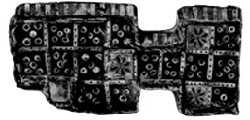brief history
The success of this game is probably related to the same reasons that makes backgammon
one of the three widest game played around the world.
Simplicity of the rules, never twice the same game and possibility of reversal until the end of the game.
However, our first evidence of the game, found in some of the royal graves of the third dynasty of Ur (Iraq)
beautifully carved with lapis-lazuli, mother-of-pearl and shells seems to attest some early religious signification.
A contemporary example found in a grave of Shar-i-shokta (Iran) let us to think that the origin of the game might
have to be seek further east especially since some artefacts of oblong dices similar to the ones used for this game
were found in Mohenjo-daro (India).
After those early appearances, the game of Twenty squares spread over
the all Near eastern world experiencing some modifications in its shape and more than likely in its rules.
It is interesting to note that in Egypt and the Levant, it is sometimes part of a reversible board displaying
the game of senet (made of 30 squares) on the other side. This can be quite easily understood by their similar
general rules, their identical use of random generator to move the pieces across the board and almost similar
number of pieces involved in the game (seven for the latter, five for the former).
It is for sure that it experienced as wide a diffusion as its Egyptian counterpart perhaps because as
well as being an entertainment device it might have been used in its early history as a divination
tool before becoming a king a popular fortune telling device.
principle
There is lots of speculations about this game whom name we do not even know.
It is not sure whether the pieces had to do a special throw before entering the game neither what
was the role of the several special squares represented on the board in their movements across the board,
but we are pretty sure that the main rule of the game was to take all five pieces from one end of the board to
the other and to bear them off before your opponent.
There was obviously some mathematical correspondence
between the number of squares the maximum throw possible with the dices used and the disposal of the special
squares on the board. Without entering into details, we could only stressed out the sexagesimal system used by
the Mesopotamian in which 5 (like the number of special squares on the board) and 12
(like the number of squares constituting the contact zone for the player and also of course the number of astrological chambers)
are important numbers as well as their habit of linking numbers to deistic entities.
More down to earth, one can notice that each piece could reach the middle of the board in only two throws of four landing
on a special square that could have entitled him to an extra throw after the first one.
It is uncertain whether opponents were able to land on each other's pieces in order to take them back to
the beginning of their journey and if so if the player could protect them by arranging them next to each other or
leaving them on special squares constituting then some sort of safe zone.
As with backgammon some variations of the rules might have coexisted over a long period of time or
might have travelled along the main stream of traders. Unfortunately, this is already pure speculation since
absolutely no written trace of the rules has been found in archaeological surveys, nor surviving through
contemporary writings. The only evidence we have about it is a Seleucidian tablet written in 176 B.C.
dealing with the astrological correspondence that can be drawn from the central line of 12 squares.
We learn through this that the pieces bore different names, that some gambling was sometimes involved
and that it was quite a popular belief that one could use the game to predict its future.
Images
Rules
Attemps to reconstruct the course of the game have always failed to prove convincing. The main reason is that everything is pure reconstruction and usually influenced by the modern games that we are used to.
Depending on your preconception one can see the game as a simple throw-and-move game where the rules would be very basic and limited to the basic moves allowed to the pieces and the final goal of the game. On the other hand one can multiplicate the rules to make those old games look pretty much like modern backgammon. You will find below two links where you can read attemps to reconstruct the rules of the so-called Royal Game of Ur:
- the first one
echoes the two main theories produced by R.C. Bell and H.J.R. Murray
- the second one
adds a couple of images to describe the way the pieces might have been moved on the board.
Also If you have the macromedia shockwave plug-in installed on your browser (you can download it from here) you can have a go
at this reconstructed version of the game offered by the British Museum
|
